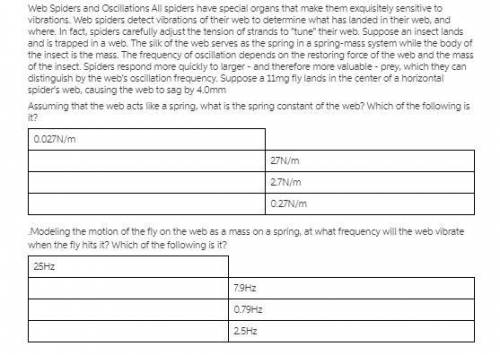
Web Spiders and Oscillations All spiders have special organs that make them exquisitely sensitive to vibrations. Web spiders detect vibrations of their web to determine what has landed in their web, and where. In fact, spiders carefully adjust the tension of strands to "tune" their web. Suppose an insect lands and is trapped in a web. The silk of the web serves as the spring in a spring-mass system while the body of the insect is the mass. The frequency of oscillation depends on the restoring force of the web and the mass of the insect. Spiders respond more quickly to larger - and therefore more valuable - prey, which they can distinguish by the web's oscillation frequency. Suppose a 14 mg fly lands in the center of a horizontal spider's web, causing the web to sag by 4.0 mm. Assuming that the web acts like a spring, what is the spring constant of the web? Which of the following is it?a. 0.027N/mb. 27N/mc. 2.7N/md. 0.27N/mModeling the motion of the fly on the web as a mass on a spring, at what frequency will the web vibrate when the fly hits it? Which of the following is it?a. 25Hzb. 7.9Hzc. 0.79Hzd. 2.5Hz

Answers: 1
Other questions on the subject: Physics

Physics, 21.06.2019 19:10, shazanah95
Athin, square metal plate measures 14 cm on each side and has emissivity of 0.60. the plate is heated to a temperature of 745°c. what is the rate at which the plate radiates energy ? the stefan-boltzmann constant is 5.67 × 10-8 w/(m2 ? k4). remember that the plate will radiate energy from both its top and bottom surfaces.
Answers: 1


Physics, 22.06.2019 15:00, koranbutterton
Astudent throws a water balloon with speed v0 from a height h = 1.76 m at an angle θ = 21° above the horizontal toward a target on the ground. the target is located a horizontal distance d = 9.5 m from the student’s feet. assume that the balloon moves without air resistance. use a cartesian coordinate system with the origin at the balloon's initial position. (a) what is the position vector, rtarge t, that originates from the balloon's original position and terminates at the target? put this in terms of h and d, and represent it as a vector using i and j. (b) in terms of the variables in the problem, determine the time, t, after the launch it takes the balloon to reach the target. your answer should not include h. (c) create an expression for the balloon's vertical position as a function of time, y(t), in terms of t, vo, g, and θ. (d) determine the magnitude of the balloon's initial velocity, v0, in meters per second, by eliminating t from the previous two expressions.
Answers: 3

Physics, 22.06.2019 22:30, milkshakegrande101
Suppose that three astronomical objects, 1, 2, and 3 are observed to lie on a line, and the distance from object 1 to object 3 is d. object 1 has four times the mass of object 3, and seven times the mass of object 2. find the distance between objects 1 and 2 for which the net force on object 2 is zero.
Answers: 1
Do you know the correct answer?
Web Spiders and Oscillations All spiders have special organs that make them exquisitely sensitive to...
Questions in other subjects:

History, 29.06.2019 08:50


Social Studies, 29.06.2019 08:50

Geography, 29.06.2019 08:50




















